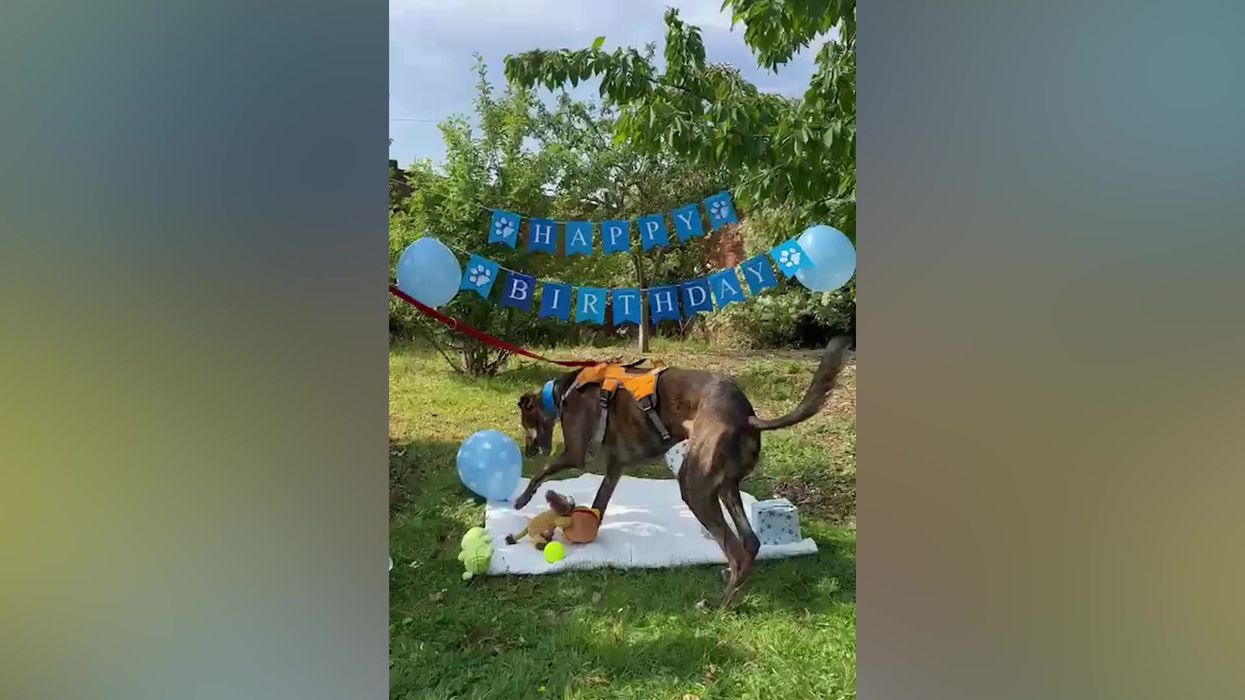A dog can be pregnant and not have a big belly if she is carrying a small litter or if she has a naturally smaller waist or flat tummy. Dogs usually begin to show subtle signs of pregnancy from around four to five weeks onwards, but each dog is different, so some may show signs later than others.
It is also possible for a dog to have a false pregnancy, where she shows signs of pregnancy but is not actually pregnant. If you have concerns about your dog’s pregnancy, it is best to consult with a veterinarian for proper guidance and care.

Credit: www.indy100.com
Understanding The Factors That Influence Dog Pregnancy Appearance
When a dog is nearing the end of its pregnancy, one common expectation is a visibly swollen belly. However, there are various factors that can influence the appearance of a pregnant dog, making it difficult to detect pregnancy, especially in the early stages.
Litter Size And Belly Swelling
In some cases, a pregnant dog may not have a noticeably swollen belly simply because she is carrying a smaller litter. The size of the litter can affect the extent to which the belly expands. Dogs with a small litter may not show the classic signs of a rounded belly that is typically associated with pregnancy.
Table: Factors that influence belly swelling in pregnant dogs
| Litter Size | Belly Swelling |
|---|---|
| Small | Less pronounced |
| Large | More pronounced |
Body Shape And Difficulty Detecting Pregnancy
Another factor that can affect the visibility of a dog’s pregnancy is its body shape. Some dogs naturally have a smaller waist or a flat tummy, which can make it challenging to detect pregnancy, even in the later stages. These dogs may not show the typical signs of a swollen belly due to their unique body shape.
Unordered List: Factors affecting pregnancy visibility in dogs
- Body shape
- Naturally smaller waist
- Flat tummy
False Pregnancy Signs
False pregnancy, also known as pseudopregnancy, is another factor that can confuse dog owners when trying to determine if their dog is pregnant. During a false pregnancy, a non-pregnant dog may exhibit signs and symptoms similar to those of a pregnant dog, including swollen mammary glands, nesting behavior, and even milk production.
- Swollen mammary glands
- Nesting behavior
- Milk production
These false pregnancy signs can be easily mistaken for real pregnancy symptoms, further complicating the visual detection of a dog’s pregnancy.
In conclusion, it’s essential to consider factors such as litter size, body shape, and the possibility of false pregnancy when trying to determine the appearance of a pregnant dog. If in doubt, it’s always best to consult with a veterinarian to confirm the pregnancy and ensure the well-being of the expecting mother.
Detecting The Signs Of Dog Pregnancy
Is your dog 60 days pregnant but not showing any signs of pregnancy? Don’t worry, it’s not uncommon for some dogs to have a small belly or show no physical changes until later stages. In this article, we will discuss the subtle signs starting around four-five weeks, followed by the more obvious signs around five-six weeks. Let’s dive in and learn how to detect the signs of dog pregnancy.
Subtle Signs Starting Around Four-five Weeks
When it comes to detecting early signs of dog pregnancy, it’s important to pay attention to subtle changes in your furry friend’s behavior and appearance. Here are some subtle signs that may indicate pregnancy:
- Decreased appetite or changes in eating habits
- Increased food cravings
- Mild abdominal enlargement
- Behavioral changes, such as increased affection or nesting behavior
While these signs may not be very noticeable at first, they can be important indicators of your dog’s pregnancy.
More Obvious Signs Around Five-six Weeks
As your dog’s pregnancy progresses, you may start noticing more obvious signs. Here are some signs that typically appear around the five-six week mark:
- Visible weight gain and a rounder abdomen
- Enlarged and pinker nipples
- A decrease in energy levels
- Increased need for urination
- Morning sickness, including vomiting or loss of appetite
If you observe these signs, it is a strong indication that your dog is indeed pregnant.
Physical Changes To Look Out For
When it comes to physical changes in a pregnant dog, there are a few things you should look out for:
| Sign | Description |
|---|---|
| Nipple Changes | Enlarged and pinker nipples are a common physical change in pregnant dogs. |
| Abdominal Enlargement | The belly will gradually get larger as the pregnancy progresses, especially towards the end. |
| Mammary Gland Development | The mammary glands may become more prominent and start producing milk closer to the due date. |
| Weight Gain | Pregnant dogs usually gain weight due to the growing puppies inside. |
By keeping an eye out for these physical changes, you can confirm the pregnancy and ensure that your dog receives the proper care during this crucial time.
Remember, every dog is unique, and the timing and intensity of these signs can vary. If you suspect that your dog is pregnant but not showing any signs, it’s always best to consult with your veterinarian for a professional evaluation.
Handling Labor Complications And Concerns
During the labor process, it is important to be prepared for any complications or concerns that may arise. Seeking veterinary help if there are labor complications, understanding potential problems during labor, and identifying factors that may contribute to stalled labor are crucial in ensuring the health and well-being of both the mother dog and her puppies.
Seeking Veterinary Help If There Are Labor Complications
If you notice any signs of labor complications, it is crucial to seek immediate veterinary help. Some common signs of complications include:
- Prolonged gestation period beyond the expected due date
- Excessive bleeding from the reproductive tract
- Dystocia (difficult or prolonged labor)
- Inability to deliver a puppy within one hour after the start of active labor
These signs may indicate underlying issues that require medical intervention. Remember, it is always better to be safe than sorry when it comes to the health of your dog and her puppies.
Understanding Potential Problems During Labor
There are several potential problems that can occur during labor. It is important to be aware of these issues and know what to do if they arise:
- Dystocia: This is a condition where the labor process becomes difficult or prolonged. It can occur due to various reasons such as the size of the puppies being too large or the birth canal being too narrow. If you suspect dystocia, it is essential to seek immediate veterinary assistance.
- Stillborn or weak puppies: Sometimes, puppies may be stillborn or born weak. Weak puppies may need extra care, and it is important to consult your veterinarian for guidance on how to nurture them properly.
- Poor contractions: If your dog is experiencing weak or infrequent contractions, it may lead to stalled labor. This situation requires veterinary attention to help stimulate contractions and ensure a smooth delivery.
Factors That May Contribute To Stalled Labor
| Factors | Description |
|---|---|
| Inadequate nutrition | Poor nutrition during pregnancy can lead to weak contractions and a higher risk of stalled labor. Ensure your dog is receiving a balanced diet specifically designed for pregnant dogs. |
| Infections | Infections in the reproductive tract can cause inflammation and hinder the progress of labor. Regular veterinary check-ups and proper hygiene can help prevent infections. |
| Poor breeding practices | Improper breeding practices, such as mating dogs with genetic disorders or incompatible sizes, can increase the risk of complications during labor. Working with a reputable breeder or veterinary professional is essential to prevent these issues. |
If you suspect any issues or are concerned about your dog’s labor progress, do not hesitate to seek veterinary assistance. It is always better to err on the side of caution to ensure the health and safety of your dog and her puppies.

Credit: www.thelabradorsite.com

Credit: www.amazon.com
Frequently Asked Questions Of My Dog Is 60 Days Pregnant And Not Showing
Can A Dog Be Pregnant And Not Have Big Belly?
A pregnant dog may not have a big belly for two reasons: a small litter size or the dog’s natural body shape. Some dogs naturally have a smaller waist or flat tummy, making it harder to detect pregnancy, even in later stages.
How Far Along Do Dogs Start Showing?
Dogs usually start showing signs of pregnancy around four to five weeks. However, every dog is different, so some may show signs later than others. More obvious signs may appear at around five to six weeks.
What If My Dog Is 62 Days Pregnant And No Signs Of Labor?
If your dog is 62 days pregnant and showing no signs of labor, it may be due to factors such as a small litter size or the dog’s body shape. Some dogs may not show obvious signs of pregnancy until later stages.
Monitor your dog closely and seek veterinary help if necessary.
Can My Dog Be Pregnant Without Showing?
Yes, it is possible for a dog to be pregnant without showing. Factors such as a small litter size or the dog’s natural body shape can make it difficult to detect pregnancy. Signs of pregnancy may become more obvious around four to five weeks.
Conclusion
It is not uncommon for pregnant dogs to not show a big belly, especially if they are carrying a small litter or have a naturally smaller waist or flat tummy. Each dog is different, and some may show signs of pregnancy later than others.
It is important to monitor your dog closely and seek veterinary help if there are any complications during labor. Remember that false pregnancy is also a possibility. Trust your instincts and consult with a professional if you have concerns about your dog’s pregnancy.



